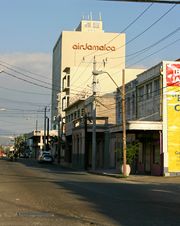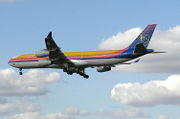Air Jamaica
|
||||
| Founded | October 1968[1] | |||
|---|---|---|---|---|
| Commenced operations | 1 April 1969[1] | |||
| Hubs | Norman Manley International Airport Sangster International Airport |
|||
| Frequent-flyer program | 7th Heaven | |||
| Member lounge | Lovebird Executive Lounge | |||
| Alliance | None | |||
| Fleet size | 2 | |||
| Destinations | 11 | |||
| Parent company | Caribbean Airlines Limited | |||
| Headquarters | Kingston, Jamaica | |||
| Key people | Dennis Lalor (Chairman) Bruce Nobles (President & CEO) |
|||
| Website | www.airjamaica.com | |||


Air Jamaica Ltd, operating as Air Jamaica, was Jamaica's national airline. The holding company of Air Jamaica is Caribbean Airlines-Air Jamaica Transition Limited and is under the control of Caribbean Airlines. [2] [3]
The former national airline of Jamaica operated scheduled services from Kingston and Montego Bay to 13 destinations in the Caribbean, Canada, the United States. The airline's acquisition by Caribbean Airlines of Trinidad and Tobago was implemented on 1 May 2010, following which there will be a projected 6-12 month transition period.[4]
Contents |
History
Air Jamaica was established in October 1968 and started operations on 1 April 1969, connecting Kingston and Montego Bay, with New York and Miami[5]. At that time the Jamaican government owned a substantial part of the airline, with Air Canada owning a minor share and providing technical, maintenance and logistical help.
During the 1970s, Air Jamaica expanded rapidly. Flights were added to Toronto and Montreal in Canada, to Luis Muñoz Marín International Airport in Puerto Rico, to Philadelphia and many other destinations, especially across the Caribbean. Long-haul services to Europe were started on 1 April 1974. Air Jamaica used Douglas DC-8s for a large part of the 1970s, but the McDonnell Douglas DC-9 and Boeing 727 jets became a part of the fleet towards the end of the decade when the government bought out Air Canada's small share. During the 1980s, growth slowed. Nevertheless, new routes were opened to Baltimore and Atlanta.
During the 1990s Air Jamaica continued to expand: the airline took over the Kingston-Nassau, Bahamas route, which had been left by British Airways, began a code sharing agreement with Delta Air Lines and opened routes to Sky Harbor International Airport in Phoenix (which was later dropped), and to Frankfurt, London, Manchester, Santo Domingo and Ft. Lauderdale. The route to Phoenix was opened because Air Jamaica was looking for expansion in the American West, beyond its route to Los Angeles. In 1994 the company was partially privatized, with the government retaining 25% of the company and giving 5% of it to the airline's employees. It began buying Airbus equipment, including the Airbus A340, and began a feeder service, a frequent flyer program (7th Heaven), and an inflight magazine, named SkyWritings.
In December 2004, after financial losses, the Government of Jamaica took back full ownership of Air Jamaica. It employed 2,522 as of March 2007.[5] The last private owner was Gordon Stewart, chairman and founder of Sandals Resorts and Beaches Resorts.[6]
In September 2007, the new Jamaican government began to consider privatization of Air Jamaica.[7] Investors with interest in the airline are speculated to be China National Aviation Holding Company (parent company of Air China), Delta Air Lines, Virgin Group (parent company of Virgin Atlantic Airways), Iberia Airlines (the national airline of Spain) and the The Emirates Group (the Emirates Group is the parent company of Emirates Airlines) and Caribbean Airlines. A private Jamaican, Spanish, British and American consortium is in talks with the Government of Jamaica to bid for the national carrier as well.[8] Air Jamaica's complete privitisation and divestment was extended from March 2009 to June 2009.[7]
In October 2007, Bruce Nobles, former President and Chief Operational Officer of Air Jamaica from May 2002 to June 2003, was asked to return to the national airline, replacing William Rogers, who was interim President and CEO of the airline since the October 2007 resignation of CEO Michael Conway.
On 4 July 2009, The Jamaica Gleaner reported that US-based Spirit Airlines had reached an agreement with the Jamaican government to acquire the national airline.[9] However, the Jamaica Observer reported on 5 July that the airline had not been sold as yet.[10]
On 17 December 2009, it was reported that the Prime Minister of Jamaica had recently approach the Government of Trinidad and Tobago regarding a possible merger or acquisition by Caribbean Airlines.[11]
It has been decided that Air Jamaica will cease to operate under Jamaican ownership and be majorly run by Caribbean Airlines until the transitional process is complete. Caribbean Airlines acquired the airline's fleet and route rights on 1 May 2010, and will open a new hub at Kingston's Norman Manley International Airport. The transition is expected to fully take place over a 6-12 month period. The acquisition makes Caribbean Airlines the largest airline in the Caribbean.[12]
Destinations
Fleet
The Air Jamaica fleet consisted of the following aircraft:
| Aircraft | In Fleet | Orders | Passengers (Lovebird Executive Class/Lovebird Economy) |
|---|---|---|---|
| Airbus A319 | 1 | 0 | 138(8/130) |
| Airbus A320-200 | 4 | 0 | 150(12/138) |
| Airbus A321-200 | 1 | 0 | 188(12/176) |
| Boeing 757-200 | 1 | 0 | Wet leased for KIN-JFK route for the summer |
| Total | 7 | 0 |
Fleet reduction and flight changes
On 27 January 2009, President and CEO Bruce Nobles announced cuts to routes, staff and fleet.[13] By 1 March 2009, Air Jamaica's fleet was reduced to nine aircraft. Air Jamaica returned five aircraft to their lessors and renegotiated the leases on the nine that they kept.
In March, Nobles announced the airline's new "Buy on Board" programme, where passengers would have the option to purchase meals in Economy class. Passengers in Lovebird and Executive classes would continue to receive free meals and drinks.[14] Nobles stated that the Buy on Board program would help Air Jamaica "be more competitive in the airline industry".[14] Routes such as Miami, Atlanta and Los Angeles were axed.
In February 2010, Air Jamaica announced that by April it would be reducing its fleet to six aircraft; one A319, four A320s and one A321. Along with these fleet cuts it would also be cutting the following routes: New York (JFK) to Grenada and Jamaica to Orlando (effective 9 March 2010), Jamaica to Chicago, Jamaica to Curacao, Jamaica to Havana and Jamaica to Nassau (by 12 April 2010). By 12 April, Air Jamaica expected to operate 161 flights a week between Jamaica and Baltimore, Philadelphia, Toronto (daily flights), New York (3 flights a day) and Fort Lauderdale (4 flights a day).[15] These route cuts are moot now that the airline will undergo transitioning operations on April 30 to finalize its divestment to Caribbean Airlines.
On July 1, 2010, Air Jamaica will continue its daily flights to Grand Cayman from Kingston and the New York JFK to Grenada route.
Aircraft previously operated

| Aircraft | Amount |
| Airbus A300B4-200 | 9 |
| Airbus A310-300 | 11 |
| Airbus A319-100 | 4 |
| Airbus A321-200 | 5 |
| Airbus A340-300 | 3 |
| Boeing 727-200 | 6 |
| Boeing 747-100 | 1 |
| Douglas DC-8-62 | 1 |
| Douglas DC-8-61 | 2 |
| Douglas DC-8-51 | 3 |
| Douglas DC-8-41 | 2 |
| McDonnell Douglas DC-9-32 | 3 |
| McDonnell Douglas MD-83 | 9 |
Air Jamaica Cargo

Air Jamaica Cargo's Head Office is at the Norman Manley International Airport in Kingston, Jamaica. Air Jamaica Cargo has 70% of the airfreight market between Jamaica and the rest of the world. Their tagline is "Freight without the wait." [17]
References
- ↑ 1.0 1.1 Norwood, Tom; Wegg, John (2002). North American Airlines Handbook (3rd ed.). Sandpoint, ID: Airways International. ISBN 0-9653993-8-9. http://www.airwaysnews.com.
- ↑ http://www.caribbeanworldnews.com/middle_top_news_detail.php?mid=3542
- ↑ http://www.stabroeknews.com/2010/regional/04/30/caribbean-airlines-to-rehire-1000-air-jamaica-workers/
- ↑ "Caribbean Airlines to re-hire 1,000 workers" by Daraine Luton, The Jamaica Gleaner, 29 April 2010
- ↑ 5.0 5.1 Flight International 27 March 2007
- ↑ "With Privatization, a New Era ahead for Air Jamaica". Travel Agent: 55. December 22, 2008. http://www.nxtbook.com/nxtbooks/questex/ta-122208/#/57/OnePage.
- ↑ 7.0 7.1 [1]
- ↑ Air J/Virgin deal a priority for new transport minister
- ↑ Report: Spirit Airlines buys Air Jamaica
- ↑ Air Jamaica not sold yet, say Gov't officials
- ↑ Jamaica PM flies in for Air Jamaica /CAL talks
- ↑ "Air Jamaica on course for possible April 12 takeover." Caribbean 360. 4 March 2010. Retrieved on 5 March 2010.
- ↑ http://www.jamaicagleaner.com/gleaner/20090128/lead/lead1.html
- ↑ 14.0 14.1 http://www.jamaica-gleaner.com/gleaner/20090321/news/news4.html
- ↑ http://www.jamaica-gleaner.com/gleaner/20100203/lead/lead5.html
- ↑ http://www.airfleets.net/flottecie/Air%20Jamaica.htm
- ↑ http://www.airjamaica.com/Cargo.aspx
External links
|
||||||||||||||||||||||||||||||||||||||||||||||||||||||||||||||||||